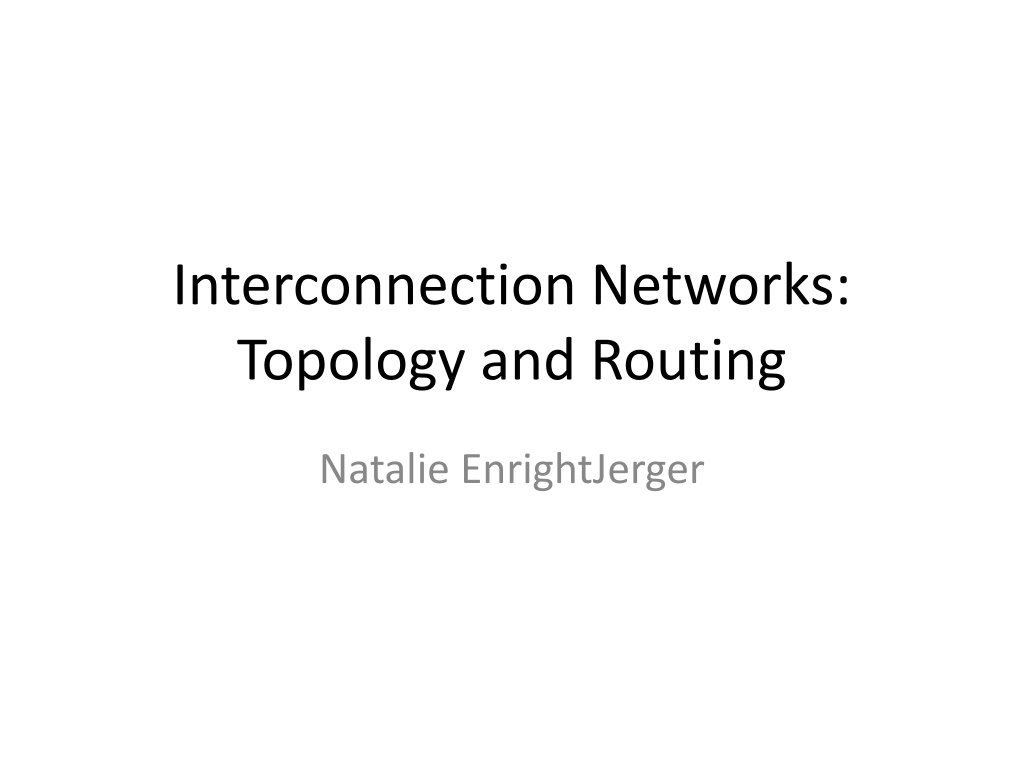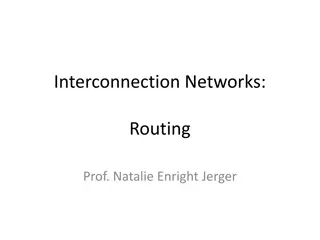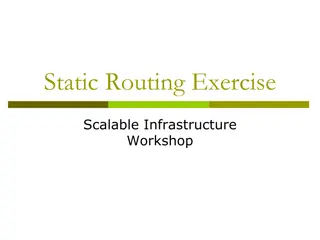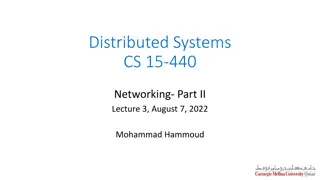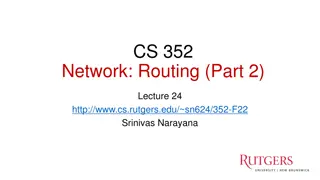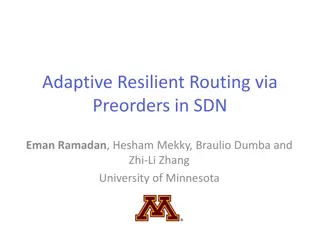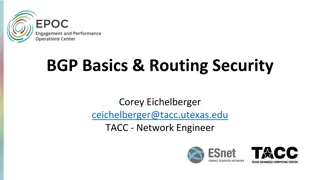Understanding Interconnection Networks: Topology and Routing
Interconnection networks play a crucial role in determining the arrangement of channels and nodes within a network, similar to a road map guiding traffic flow. Topology overview defines the network structure, while abstract metrics help evaluate performance and cost. Latency and throughput are key factors impacted by network topology, affecting data transfer speeds and efficiency. Bisection bandwidth and maximum channel load are vital considerations for optimizing network performance.
Download Presentation

Please find below an Image/Link to download the presentation.
The content on the website is provided AS IS for your information and personal use only. It may not be sold, licensed, or shared on other websites without obtaining consent from the author. Download presentation by click this link. If you encounter any issues during the download, it is possible that the publisher has removed the file from their server.
E N D
Presentation Transcript
Interconnection Networks: Topology and Routing Natalie EnrightJerger
Topology Overview Definition: determines arrangement of channels and nodes in network Analogous to road map Often first step in network design Routing and flow control build on properties of topology
Abstract Metrics Use metrics to evaluate performance and cost of topology Also influenced by routing/flow control At this stage Assume ideal routing (perfect load balancing) Assume ideal flow control (no idle cycles on any channel) Switch Degree: number of links at a node Proxy for estimating cost Higher degree requires more links and port counts at each router
Latency Time for packet to traverse network Start: head arrives at input port End: tail departs output port Latency = Head latency + serialization latency Serialization latency: time for packet with Length L to cross channel with bandwidth b (L/b) Hop Count: the number of links traversed between source and destination Proxy for network latency Per hop latency with zero load
Impact of Topology on Latency Impacts average minimum hop count Impact average distance between routers Bandwidth
Throughput Data rate (bits/sec) that the network accepts per input port Max throughput occurs when one channel saturates Network cannot accept any more traffic Channel Load Amount of traffic through channel c if each input node injects 1 packet in the network
Maximum channel load Channel with largest fraction of traffic Max throughput for network occurs when channel saturates Bottleneck channel
Bisection Bandwidth Cuts partition all the nodes into two disjoint sets Bandwidth of a cut Bisection A cut which divides all nodes into nearly half Channel bisection min. channel count over all bisections Bisection bandwidth min. bandwidth over all bisections With uniform traffic of traffic cross bisection
Throughput Example 0 1 2 3 4 5 6 7 Bisection = 4 (2 in each direction) With uniform random traffic 3 sends 1/8 of its traffic to 4,5,6 3 sends 1/16 of its traffic to 7 (2 possible shortest paths) 2 sends 1/8 of its traffic to 4,5 Etc Channel load = 1
Path Diversity Multiple minimum length paths between source and destination pair Fault tolerance Better load balancing in network Routing algorithm should be able to exploit path diversity We ll see shortly Butterfly has no path diversity Torus can exploit path diversity
Path Diversity (2) Edge disjoint paths: no links in common Node disjoint paths: no nodes in common except source and destination If j = minimum number of edge/node disjoint paths between any source-destination pair Network can tolerate j link/node failures
Symmetry Vertex symmetric: An automorphism exists that maps any node a onto another node b Topology same from point of view of all nodes Edge symmetric: An automorphism exists that maps any channel a onto another channel b
Direct & Indirect Networks Direct: Every switch also network end point Ex: Torus Indirect: Not all switches are end points Ex: Butterfly
Torus (1) K-ary n-cube: kn network nodes n-dimensional grid with k nodes in each dimension 3-ary 2-cube 3-ary 2-mesh 2,3,4-ary 3-mesh
Torus (2) Topologies in Torus Family Ring k-ary 1-cube Hypercubes 2-ary n-cube Edge Symmetric Good for load balancing Removing wrap-around links for mesh loses edge symmetry More traffic concentrated on center channels Good path diversity Exploit locality for near-neighbor traffic
Torus (3) nk 4 k even = H 1 k 4 min n k odd 4 k Hop Count: Degree = 2n, 2 channels per dimension
Channel Load for Torus Even number of k-ary (n-1)-cubes in outer dimension Dividing these k-ary (n-1)-cubes gives a 2 sets of kn-1 bidirectional channels or 4kn-1 Traffic from each node cross bisection N k k = = channel load 2 4 8 N Mesh has the bisection bandwidth of torus
Torus Path Diversity y + x = Rxy x 2 dimensions* R = = , 2 = 2 x y 6 xy = 24 R NW, NE, SW, SE combos xy ( ) ! 1 n = 1 n ! i 1 n j = = = n 0 i R = j i xy 1 i i 0 2 edge and node disjoint minimum paths i = 0 i n dimensions with i hops in i dimension *assume single direction for x and y
Implementation Folding Equalize path lengths Reduces max link length Increases length of other links 0 1 2 3 3 2 1 0
Concentration Don t need 1:1 ratio of network nodes and cores/memory Ex: 4 cores concentrated to 1 router
Butterfly K-ary n-fly: kn network nodes Example: 2-ary 3-fly Routing from 000 to 010 Dest address used to directly route packet Bit n used to select output port at stage n 0 1 0 0 0 00 10 20 1 1 2 2 01 11 21 3 3 4 4 02 12 22 5 5 6 6 03 13 23 7 7
Butterfly (2) = 1 R No path diversity Hop Count Logkn + 1 Does not exploit locality Hop count same regardless of location Switch Degree = 2k Channel Load uniform traffic xy ) 1 + n ( k n NH = = 1 min C ) 1 + n ( k n Increases for adversarial traffic
Flattened Butterfly Proposed by Kim et al (ISCA 2007) Adapted for on-chip (MICRO 2007) Advantages Max distance between nodes = 2 hops Lower latency and improved throughput compared to mesh Disadvantages Requires higher port count on switches (than mesh, torus) Long global wires Need non-minimal routing to balance load
Flattened Butterfly Path diversity through non-minimal routes
Clos Network rxr input switch nxm input switch mxn output switch rxr input switch nxm input switch mxn output switch rxr input switch nxm input switch mxn output switch rxr input switch nxm input switch mxn output switch rxr input switch
Clos Network 3-stage indirect network Characterized by triple (m, n, r) M: # of middle stage switches N: # of input/output ports on input/output switches R: # of input/output switching Hop Count = 4
Folded Clos (Fat Tree) Bandwidth remains constant at each level Regular Tree: Bandwidth decreases closer to root
Fat Tree (2) Provides path diversity
Common On-Chip Topologies Torus family: mesh, concentrated mesh, ring Extending to 3D stacked architectures Favored for low port count switches Butterfly family: Flattened butterfly
Topology Summary First network design decision Critical impact on network latency and throughput Hop count provides first order approximation of message latency Bottleneck channels determine saturation throughput
Routing Overview Discussion of topologies assumed ideal routing Practically though routing algorithms are not ideal Discuss various classes of routing algorithms Deterministic, Oblivious, Adaptive Various implementation issues Deadlock
Routing Basics Once topology is fixed Routing algorithm determines path(s) from source to destination
Routing Algorithm Attributes Number of destinations Unicast, Multicast, Broadcast? Adaptivity Oblivious or Adaptive? Local or Global knowledge? Implementation Source or node routing? Table or circuit?
Oblivious Routing decisions are made without regard to network state Keeps algorithms simple Unable to adapt Deterministic algorithms are a subset of oblivious
Deterministic All messages from Src to Dest will traverse the same path Common example: Dimension Order Routing (DOR) Message traverses network dimension by dimension Aka XY routing Cons: Eliminates any path diversity provided by topology Poor load balancing Pros: Simple and inexpensive to implement Deadlock free
Valiants Routing Algorithm To route from s to d, randomly choose intermediate node d Route from s to d and from d to d. Randomizes any traffic pattern All patterns appear to be uniform random Balances network load Non-minimal d d s
Minimal Oblivious Valiant s: Load balancing comes at expense of significant hop count increase Destroys locality Minimal Oblivious: achieve some load balancing, but use shortest paths d must lie within minimum quadrant 6 options for d Only 3 different paths d s
Adaptive Uses network state to make routing decisions Buffer occupancies often used Couple with flow control mechanism Local information readily available Global information more costly to obtain Network state can change rapidly Use of local information can lead to non-optimal choices Can be minimal or non-minimal
Minimal Adaptive Routing d s Local info can result in sub-optimal choices
Non-minimal adaptive Fully adaptive Not restricted to take shortest path Example: FBfly Misrouting: directing packet along non- productive channel Priority given to productive output Some algorithms forbid U-turns Livelock potential: traversing network without ever reaching destination Mechanism to guarantee forward progress Limit number of misroutings
Non-minimal routing example d d s s Longer path with potentially lower latency Livelock: continue routing in cycle
Routing Deadlock A B D C Without routing restrictions, a resource cycle can occur Leads to deadlock
Turn Model Routing North last West first Negative first Some adaptivity by removing 2 of 8 turns Remains deadlock free (like DOR)
Turn Model Routing Deadlock Not a valid turn elimination Resource cycle results
Routing Implementation Source tables Entire route specified at source Avoids per-hop routing latency Unable to adapt to network conditions Can specify multiple routes per destination Node tables Store only next routes at each node Smaller tables than source routing Adds per-hop routing latency Can adapt to network conditions Specify multiple possible outputs per destination
Implementation Combinational circuits can be used Simple (e.g. DOR): low router overhead Specific to one topology and one routing algorithm Limits fault tolerance Tables can be updated to reflect new configuration, network faults, etc
Circuit Based sx x sy y =0 =0 Productive Direction Vector exit +y +x -y -x Queue lengths Route selection Selected Direction Vector exit +y +x -y -x
Routing Summary Latency paramount concern Minimal routing most common for NoC Non-minimal can avoid congestion and deliver low latency To date: NoC research favors DOR for simplicity and deadlock freedom On-chip networks often lightly loaded Only covered unicast routing Recent work on extending on-chip routing to support multicast
Bibliography Topology William J. Dally and C. L Seitz. The torus routing chip. Journal of Distributed Computing, 1(3):187 196, 1986. Charles Leiserson. Fat-trees: Universal networks for hardware efficient supercomputing. IEEE Transactions on Computers, 34(10), October 1985. Boris Grot, Joel Hestness, Stephen W. Keckler, and OnurMutlu. Express cube topologies for on-chip networks. In Proceedings of the International Symposium on High Performance Computer Architecture, February 2009. Flattened butterfly topology for on-chip networks. In Proceedings of the 40th International Symposium on Microarchitecture, December 2007. J. Balfour and W. Dally. Design tradeoffs for tiled cmp on-chip networks. In Proceedings of the International Conference on Supercomputing, 2006. Routing L. G. Valiant and G. J. Brebner. Universal schemes for parallel communication. In Proceedings of the 13th Annual ACM Symposium on Theory of Computing, pages 263 277, 1981. D. Seo, A. Ali, W.-T. Lim, N. Rafique, and M. Thottenhodi. Near-optimal worst- case throughput routing in two dimensional mesh networks. In Proceedings of the 32nd Annual International Symposium on Computer Architecture, June. Christopher J. Glass and Lionel M. Ni. The turn model for adaptive routing. In Proceedings of the International Symposium on Computer Architecture, 1992. P. Gratz, B. Grot, and S. W. Keckler, Regional congestion awareness for load balance in networks-on-chip, in Proceedings of the 14th IEEE International Symposium on High-Performance Computer Architecture, February 2008. N. EnrightJerger, L.-S. Peh, and M. H. Lipasti, Virtual circuit tree multi- casting: A case for on-chip hardware multicast support, in Proceedings of the International Symposium on Computer Architecture (ISCA-35), Beijing, China, June 2008.
